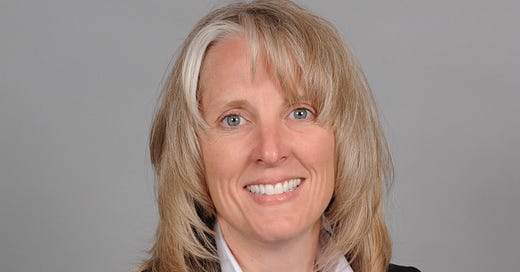Grading cow tech's impact on animal welfare
Machine learning gets the hang of predicting heat-stressed cows
In case you missed it … Q&A with Jennifer Walker
This week I did an interview with Danone North America's Director of Quality Care Dr. Jennifer Walker for Progressive Dairy. We talk about where technology has the potential to help farmers and processors advance their shared interest of meeting consumer expectations. She comments on robotic milking, computer vision, video monitoring and blockchain technologies.
Check out her answer to this question: "Grade technology's current impact on animal welfare and milk quality. What letter grade would you give it?"
Find the answer here.
New newsletter about robotic milking for large herds
If you're interested in the application of robotic milking for large herds, here's a newsletter that might intrigue you. Researchers at UC-Davis and the University of Minnesota are studying the opportunities and risks of implementing automatic milking systems on large dairies. They are reviewing what has been published about the topic already and doing original interviews with dairy farmers as part of their research. This newsletter shares updates on their work.
The current issue has an interview with the first California dairy to install a milking robot. One of the managers of that dairy says he believes you could manage up to 300 cows per full-time employee with milking robots.
To subscribe to the newsletter or read the current issue, click here.
What computer vision needs to watch for to catch heat-stressed cows
Heat stress research at Mississippi State University recently identified three cow behavior features that computer vision could perhaps look for to preemptively predict heat stress in cattle. The researchers determined that drooling, respiratory rates, and decreases in DIM are the features that drive heat stress. Their work aimed to build a machine learning model that could ingest and analyze data about these behaviors and help non-human monitors of such behaviors observe changes and then predict the early-onset of heat stress. The authors claim, "The findings from this study provide a new tool to assess heat stress in dairy cows."
Read more about the research here [subscription required].
Register now for Animal AgTech Innovation Summit
If you haven’t already, register to join me, Editor Walt Cooley, at the virtual Animal AgTech Innovation Summit (March 8) and connect with 350+ of the world’s leading animal health and nutrition businesses, livestock and aquaculture producers, start-ups and investors for a jam-packed day of looking into how to accelerate innovation in animal welfare, sustainability, and farm-to-fork solutions.
Use the discount code PROD10 to save 10 percent on your registration. Book your place now: http://bit.ly/2HyvNqb
Note: I don’t receive any portion of the registration fees collected from using the above-mentioned link or promo code.
Here's some cow technologies that will be presenting and participating in this year's event:
ARMENTA (Israel) has developed the first non-antibiotic treatment for bovine mastitis using acoustic pulse technology (APT). Infected cows treated with the technology have shown 70% cure rates and consequently a 10% increase in milk yield, the company claims.
BEZOAR LABORATORIES (USA) is a research and development company dedicated to bringing powerful innovations to market that benefit farm animals, the planet and producers. Its first product is Fortis, a probiotic that reduces enteric methane formation in ruminant by 50%.
EMGENISYS (USA) has created the world’s most comprehensive embryo evaluation system to improve pregnancy outcomes of assisted reproductive technologies (ARTs) in livestock. The company’s technology utilizes computer vision to evaluate real-time cellular activity in bovine embryos in the lab or chute side.
PRECISION LIVESTOCK TECHNOLOGIES (USA) delivers actionable intelligence to the livestock industry. Its machine vision and artificial intelligence platform helps producers increase profits while improving quality and animal well-being. Its initial target market is the beef cattle feedlot industry, where its bunk management system delivers metrics that optimize feeding, save on labor, and provide accurate data to consulting nutritionists and veterinarians.
ONECUP AI (Canada) has an animal facial recognition technology that tracks livestock individually and at scale using only computer vision. Its AI, Bovine Expert Tracking and Surveillance or BETSY, monitors and analyzes health, growth, activity and nutrition. Its first product is an AI-powered calving camera that notifies ranchers when a heifer needs help.
RAKR (Canada) is saving farms over $30,000 annually by improving margins through smart and effective cost-cutting measures. Its first device, the NeatMeter, is a sensor solution that collects and processes barn data to make farms more energy efficient and reduce machine breakdowns through predictive maintenance.
SOMADETECT (Canada) provides farmers with the information they need to make the best possible milk. The company’s core technology is an inline sensor capable of monitoring critical indicators of reproductive status, health, and milk components from individual cows at every milking.
Profit projections from ZISK
Projected profitability for two dairy herd sizes have INCREASED SLIGHTLY in the last two weeks, according to profit projections from ZISK.
ZISK is a profit-projection smartphone app that tracks individual dairy farm profitability based on current CME board prices. Projections for a 1,000-cow dairy producing an average of 80 pounds of milk per cow and a 2,500-cow dairy producing an average of 85 pounds of milk per cow are provided.
12-month dairy farm profit projections (as of Feb. 19, 2021):
1,000-cow dairy = $87,447 (UP about $12,300 since the beginning of 2021)
2,500-cow dairy = $904,095 (UP about $31,500 since the beginning of 2021)







